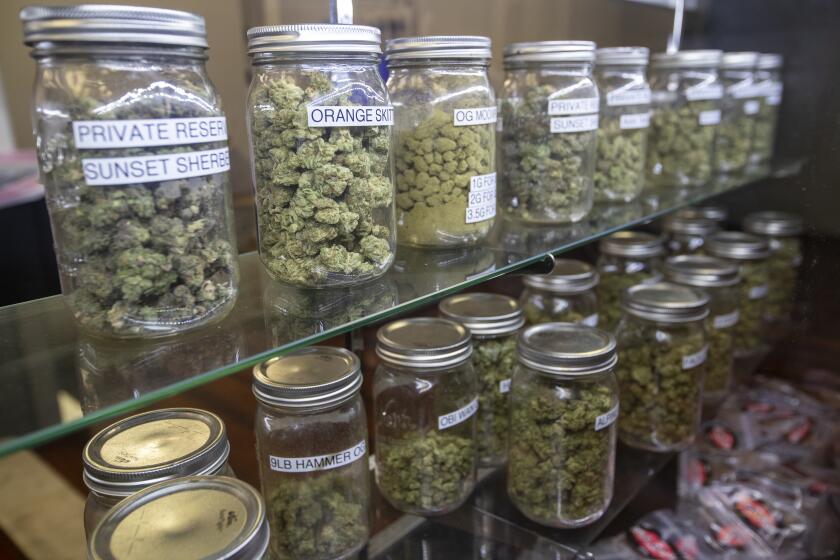Estimate of Recall Now $66 Million
California’s top election official said Monday that the recall election is expected to cost about $66 million -- the high end of previous estimates -- and warned that there will be missteps along the way to a final certification of the outcome, which may be as late as Nov. 15.
“Let me be candid: There are going to be problems,” said Secretary of State Kevin Shelley. “You play with the cards you’re dealt.”
On Monday, with 56 days to go before the vote, there were these developments:
* More Democratic leaders moved toward a two-part strategy, urging a “no” vote on the recall ballot while supporting Lt. Gov. Cruz Bustamante as the best backup candidate. Davis and his wife, Sharon, made campaign appearances emphasizing his work on behalf of Californians.
* Prominent Republicans in the race took shots at one another in campaign appearances and interviews and questioned where fellow Republican Arnold Schwarzenegger stands on issues facing the state. Schwarzenegger appeared in New York City at an event touting after-school programs, refusing to answer reporters’ questions about his run for the governorship.
* Shelley conducted a lottery in Sacramento to determine the order in which candidates’ names will appear on the ballot. Names beginning with R will top the ballot in the 1st Assembly District, and ballot order will rotate through the alphabet in other districts.
As of Monday, 96 candidates had qualified to appear on the ballot in the state’s first recall vote on a sitting governor, only the second such election nationwide in a century. Shelley’s office was still reviewing 95 additional names, but country registrars say that they believe the secretary of state’s list includes several invalid names and that the final count will end up closer to 150 than 200.
Voters will be asked to make two decisions Oct. 7. First they will vote up or down on whether Davis should keep his job as governor. Then they will have the option of choosing who should replace Davis if the recall effort succeeds. If Davis fails to get the support of more than 50% of voters on the first question, whoever gets the largest number of votes on the second part of the ballot will become governor.
Of the estimated $66-million cost of the recall election, about $11 million will come from the state and the rest from county governments. County election officials said Monday that the recall vote will require them to spend money that had been set aside for the presidential primary in March. That means there is money on hand to deal with the recall costs, but county officials said they were worried about financial repercussions.
“It’s like we’re spending next month’s rent or grocery bill,” said Michael Petrucello, assistant registrar-recorder clerk for Los Angeles County, where recall election costs are expected to reach $13.3 million. “We’re spending money we don’t have. We really are.”
Costs have escalated because of the large number of candidates qualified for the ballot, officials said. Ventura County officials, for example, revised their estimate of the recall costs from $800,000 to $1 million after the increase in the number of candidates this weekend.
One big-cost item is first-class postage to ensure that ballot pamphlets arrive in 11 million California households on time. Normally, ballot pamphlets are mailed at a lower postal rate that allows slower delivery.
The size of the pamphlet also will add to the bill. Each candidate will be entitled to make a 250-word statement. With three statements per page, the pamphlet could exceed 50 pages.
As details of running the special election were sorted out, campaigning continued.
Davis posed before dozens of cameras at an appearance Monday morning at the Museum of Tolerance on Pico Boulevard in Los Angeles. He called Bustamante “a good and decent person.” He added that he took Bustamante “at his word” that the lieutenant governor opposes the recall election, despite having chosen to run.
As he has before, Davis called the recall effort an insult to California voters.
“I may be old-fashioned,” he said, “but I come from the school where, once an election has passed, and someone is chosen to be the leader, everyone gets behind that leader and does the people’s business for the next four years.”
In Sacramento, Bustamante released copies of his income tax returns for 1998 through 2002, calling on other candidates to do the same. (Schwarzenegger released two years of income tax filings on Sunday.)
Over those years, Bustamante and his wife reported income that ranged from $104,000 to $152,000, with most of the money coming from his government salary. He made charitable contributions that varied from year to year from several hundred to several thousand dollars.
Answering questions from reporters, Bustamante called himself an “average guy trying to an above-average job.”
“I know there is this Arnold mania.... How do you get through that?” he said. “I think there is going to be a long enough campaign for people to be able to see who they believe is going to have the right kind of solutions and who is sincere and able to do it.”
He said he had stopped short of endorsing Davis, even as he urged voters to defeat the recall effort, because “I think the governor can praise himself.” Voters had twice said Bustamante was capable of stepping into the governorship when they voted for him as lieutenant governor, he added.
Other Democratic politicians have begun describing Bustamante as “courageous” or “gutsy” for stepping into the race, part of what seems to be an emerging party strategy of praising the lieutenant governor for putting his name forward.
Still, the Democrats are far from unified, and reactions to Bustamante’s candidacy run a spectrum from endorsement to hostility.
Rep. Brad Sherman (D-Sherman Oaks) has been among the strongest advocates of backing a candidate on the second part of the ballot. “We don’t skip votes; we don’t waste votes; we vote for Cruz Bustamante,” he said.
Overall, however, Democratic members of Congress continued to wrestle with the issue Monday as House Minority Leader Nancy Pelosi (D-San Francisco) conferred with her colleagues in a conference call. Pelosi has given Bustamante some help behind the scenes, but she has stopped short of publicly endorsing him.
“We’re going to fight the recall and hope it won’t be necessary to have an alternative,” Pelosi said in statement Monday. “I’m glad we have only one Democratic candidate on the ballot. At the end of the day, there will be a Democratic governor of California.”
Further along the spectrum, U.S. Sen. Dianne Feinstein (D-Calif.) said this weekend that her fellow Democrats were practicing hypocrisy in backing a candidate to replace Davis. Aides said Monday that the senator still planned to skip the second half of the ballot.
On the Republican side, some prominent recall candidates took shots at one another in campaign appearances and interviews.
Bill Simon Jr., who ran unsuccessfully against Davis in 2000, said in an interview with Roger Hedgecock, the talk radio host on KOGO-AM (600) in San Diego, that state Sen. Tom McClintock (R-Thousand Oaks), a rival for conservative votes, “is not going to have the resources” to run a competitive race.
Simon called McClintock a good man but said “we have to question, you know, where Tom is going to be in a couple of weeks when he is not on TV and he is not on radio because he doesn’t have the resources.”
For his part, McClintock, in an interview with The Times, called himself the sole conservative with a chance of winning.
“I was the top Republican vote-getter in California last year” when he ran for state treasurer. “I received 103,000 more votes than the Republican for governor, and I was running down-ticket,” he said.
Although Schwarzenegger has had little to say publicly on his political views since announcing his candidacy last week on “The Tonight Show With Jay Leno,” he is widely believed to support abortion rights and adoption by gay parents, positions at odds with those of many of the state’s conservative voters.
Schwarzenegger was in New York to announce a name change in the Inner-City Games Foundation started by him and his wife, NBC News correspondent Maria Shriver. The foundation will be known as After-School All-Stars. While the event had been billed in part as a news conference, he took no questions.
TV cameras were allowed to accompany him on a tour of the summer camp run by the foundation on the campus of City College.
Pressed on why there would be no questions, an aide said: “There’s no questions because this event is about the children. Mr. Schwarzenegger is not here to campaign. He does not want to diminish that.”
To this, a radio reporter yelled: “Maybe my information was wrong. Isn’t he running for governor of California?”
Karen Hanritty, Schwarzenegger’s press secretary, would not comment on meetings the candidate had before his return to Los Angeles by private jet. The meetings were not official fund-raising opportunities, she said, but she would not explain further. One of the meetings was a lunch with major Republican donors arranged by New York’s Republican Gov. George Pataki, according to Associated Press.
Also on Monday, Arianna Huffington, who was once a prominent Republican advocate and is running as an unaffiliated candidate, opened her campaign office in Los Angeles. The commentator and author, who said she hadn’t “slept past 3 a.m.” since announcing her candidacy last week, said she would “debate anyone, anytime, anywhere.”
And Ralph Nader, the Green Party’s 2000 presidential candidate, announced he would endorse Green Party gubernatorial hopeful Peter Camejo at a news conference in San Francisco today. How the ballot will look became somewhat clearer Monday after the secretary of state’s office conducted the lottery to determine the lineup of candidates -- a tradition required by law.
Officials placed each of the 26 letters of the alphabet into separate 35-millimeter film canisters, dropped them into a drum, then pulled them out, one by one.
The first letter drawn was R. Election officials continued to draw letters until all were pulled, creating, in effect, a new alphabet to be followed for the ballot.
The process is intended to ensure that no candidate gets an unfair advantage by appearing at the top of the ballot in every district.
The random order may pose problems in an election with so many candidates in a single race, making it necessary to scan the entire ballot to find a voter’s choice.
Times staff writers Nick Anderson, Miguel Bustillo, Sue Fox, Daryl Kelley, Joe Mathews, Jennifer Oldham and Nancy Vogel contributed to this report.
More to Read
Get the L.A. Times Politics newsletter
Deeply reported insights into legislation, politics and policy from Sacramento, Washington and beyond. In your inbox three times per week.
You may occasionally receive promotional content from the Los Angeles Times.












